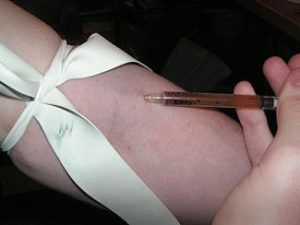I’ll be the first to admit that I couldn’t actually stomach the final, fully collapsed sequence of Requiem for a Dream. The film, centered on its characters’ various drug use habits, does depict some pretty intense and disturbing realities of drug abuse. However, like Trainspotting and Blow (albeit in a much different way), Requiem for a Dream still stands guilty of romanticizing drug use.

While these films don’t seem to set out with goals of romanticizing drug use or glorifying the junkie, I’m not sure the digression of their characters is enough to gloss over the suggestively glorious highs of their addictions. The success of these films may appear high in currency, but romanticizing drug use through such a commercially and culturally popular medium is incredibly dangerous.
Glorious Highs
All three of these movies, Requiem for a Dream, Trainspotting, and Blow, give a lot of screen time to the highs drugs cause. Films about drug use and addiction – as well as films that attempt to casually plant drug abuse as a side note – typically give a lot of focus to explicitly explaining to the audience how glorious these highs can be.
While Trainspotting’s characters mention a variety of different drugs, they primarily harbor heroin addictions. And the protagonist narrator, Renton, does not leave it up to artistic camera shots and cinematographic conventions to explain the high heroin gives. Renton explicitly tells us how glorious that high is. While in the midst of his own high, Renton explains that even multiplying your best orgasm by 1,000 will still not even come close to matching the glorious euphoria of a heroin high. We can name that Exhibit A in the film’s tribute to romanticizing drug use.
It’s an incredibly dangerous piece of monologue for a film to put out there. By issuing the comparison in the first place, you’re assuming your audience isn’t versed in the effects of heroin. It’s essentially a curiosity spark. Ewan McGregor, the actor behind Renton, admitted that he himself even dabbled with the idea of trying heroin. He questioned how he could possibly play a heroin addict if he had never tried the drug. However, “trying the drug” still doesn’t give you the experience needed to perform as a drug addict. And that experience isn’t something you want either.
 Effects of Heroin Addiction:
Effects of Heroin Addiction:
- Extreme weight loss
- Bacterial infections in the blood
- Abscesses
- Liver disease
- Kidney disease
But Trainspotting isn’t alone. Again, most films that include drug abuse do the same. Their explicitness may not be as verbal but it’s no less conspicuous. For example, Requiem for a Dream uses two of its characters (Harry and Marion) to pair love and ease with the highs of their drugs of choice, which appear to be heroin and cocaine. However, this film relies more heavily on cinematography and nonverbal scenes to associate a drug-induced high with a happy life. Of course, that’s stripped away later in the film. And Blow lets its audience associate drug use with success, fun, and popularity before it lets the gradual negative social and behavioral effects create their mark as the film’s main themes.
These movies, as well as many other representations of drug abuse in film, are not necessarily wrong, but they are romanticizing drug use in a way that potentially adds fuel to the addiction epidemic.
Faded Lows
Films about drug use and addiction tend to leave the negative side effects of these disorders to their larger, more overarching themes. Admittedly, that doesn’t deviate too far from reality. Addiction is a disease that affects every part of a person’s life. And its long-term consequences are some of the worst aspects of the disease (if you could actually put those effects in a hierarchy at all). However, leaving the negative effects of drug abuse as material for theme only works when your whole audience watches the film through a thematic lens. But that’s not to say that these movies aren’t powerful. Johnny Depp’s portrayal of George Jung’s distress at losing his relationship with his daughter in Blow is incredibly heartbreaking. And Requiem for a Dream’s final sequence, as I mentioned earlier, is enough to leave a person speechless and sympathetically despondent for hours after the closing credits.
But giving these negative consequences thematic power actually adds to the whole idea of romanticizing drug use. You don’t get that same explicitness out of the lows of drug use that you do with the highs in these films. Sure, Tommy dying of an opportunistic illness after contracting HIV in Trainspotting and Sara Goldfarb being institutionalized for her drug-induced psychosis in Requiem for a Dream seem like pretty explicit examples of the negatives of drug abuse. But they can’t exactly compare to someone explaining that you’ll never feel anything as great as a heroin high or the almost-jealous feeling you get when you see a couple so in love and so peaceful during their shared high. That is, until you look at the film as a whole and pit those highs against the lows.
It also doesn’t help that those who have not been gripped by the insidious grasp of addiction feel detached from the lows that the characters in these films experience. Giving the negatives of drug use thematic value fades those lows compared to the sharp potency of the highs when such detachment is involved. We make ourselves feel better about those lows by explaining that it’s just a movie with characters, not real life with real people. Meanwhile, those glorious highs stay engaging and enigmatic.
Romanticizing Drug Use Does Addiction No Favors
Addiction is incredibly dangerous and potentially deadly. Transforming it into romanticized art only adds to that danger unless the art is purely informational. But that’s essentially an oxymoron, as art is meant to be interpreted and potentially meaningful. So, where does that leave us in regards to movies like Requiem for a Dream, Trainspotting, and Blow?
All three of these movies – like many others – do point out the negatives of drug addiction, albeit in a much more artistic and contained way than reality. But to romanticize the highs is incredibly dangerous.
There is nothing glorious or glamorous about putting all the value in your life on a substance. Feeling as if nothing else can compare to the high you get with your drug of choice. And it’s true. If you develop a dependency on a drug, you eventually won’t be able to feel happy – or even normal for that matter – without it. Furthermore, when films pair characters who struggle with addiction together, it actually minimizes the addiction. It’s not one person struggling; it’s a few people struggling together. Somehow, that makes it more okay. And you don’t have to focus on how horrible one character’s digression is because the effects are spread out over a group of people. But destroying your body and mind from the inside out is not at all romantic, even if it’s done with other people.
Romanticizing drug use really does minimize addiction.
We look at these characters on our screens and feel for their tragic stories. We root for them to get better. And we watch their undoing. Then we get up and remember that it was just a movie with a tragic plot. They’re not addicts. They’re characters who struggled with drugs. Or so we tell ourselves. Addiction becomes this romanticized, unrealistic piece of a film plot rather than standing front and center as the real-life, destructive epidemic that it actually is.

No matter what these films might show you, addiction is not a normal part of culture.
Yes, it does affect millions of people in our country alone, but it is not commonplace. And to think so makes it seem acceptable. It’s not. Addiction is a harmful and potentially deadly disease that destroys so many people’s lives. We can watch that destruction in movies, but romanticizing drug use and not giving factual information about it will, again, only add fuel to addiction. So, let’s look at that information…
Sara Goldfarb, the mother in Requiem for a Dream, seemed to be on some kind of amphetamine disguised as diet pills. The men in Trainspotting gravitate towards heroin, but Renton also develops a dependency to methadone at one point. Methadone accounts for almost one-third of opioid-related deaths. And Blow is more focused on the trafficking part of the drug world. But its characters do also partake in cocaine abuse.
Effects of Amphetamine Addiction:
- Severe anxiety
- Teeth grinding
- Erectile dysfunction
- Irregular heartbeat and heart palpitations
- Cognitive impairment
- Nausea
Side Effects of Methadone:
- Nausea and vomiting
- Low blood pressure
- Irregular heartbeat
- Insomnia
- Lost appetite
Effects of Cocaine Abuse and Addiction:
- Unusual aggression
- Depression
- Enlarged heart
- Paranoia
- Nosebleeds
- Cardiac arrest
These drugs are incredibly dangerous. The drug use and consequential destruction and downfall of the characters in these films are not romantic in the least. It’s also not impossible, fantastical, or unrealistic, despite its almost-hyperbolic portrayal in these films. Addiction is very real and very harmful.
Fortunately, no one has to endure the destruction. Addiction can be treated. If you or someone you know is struggling with addiction, please don’t hesitate to reach out. New Start can help. Call us at 855-737-7363 for a free and confidential screening.

